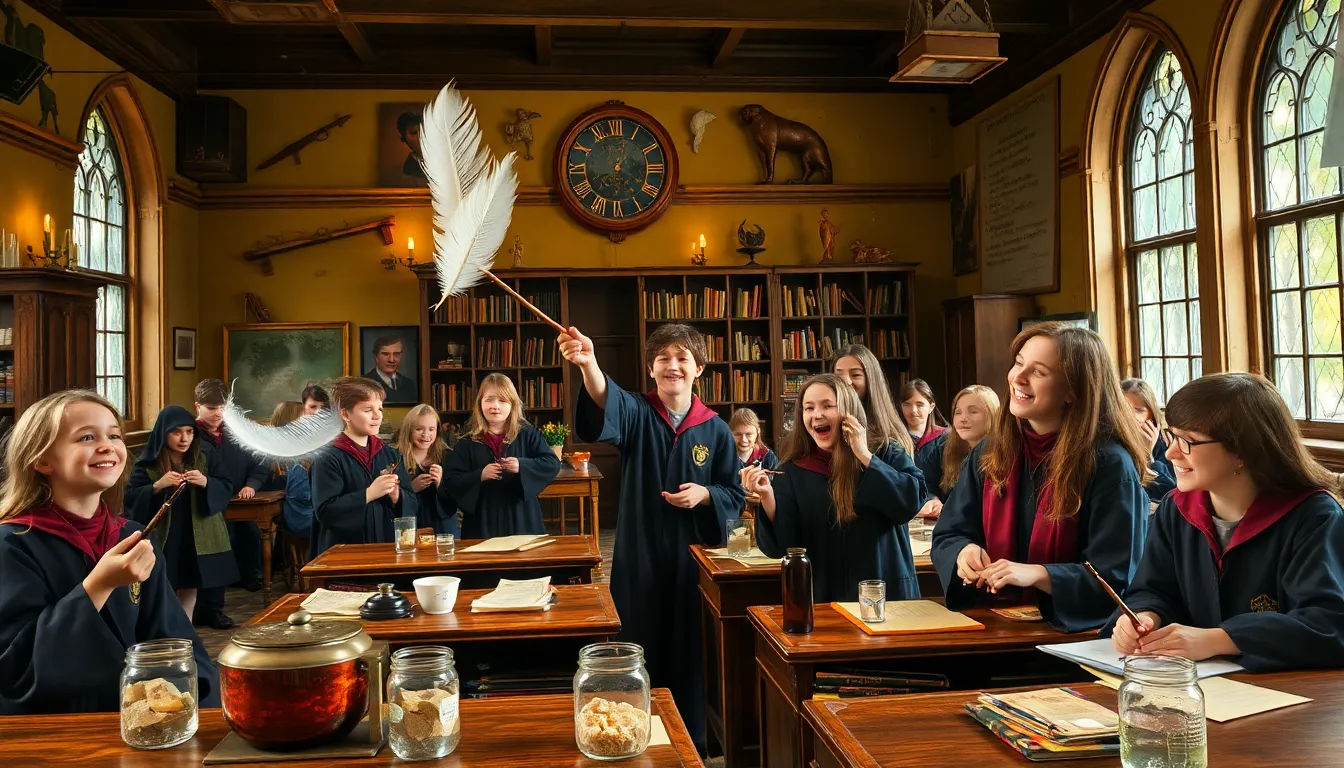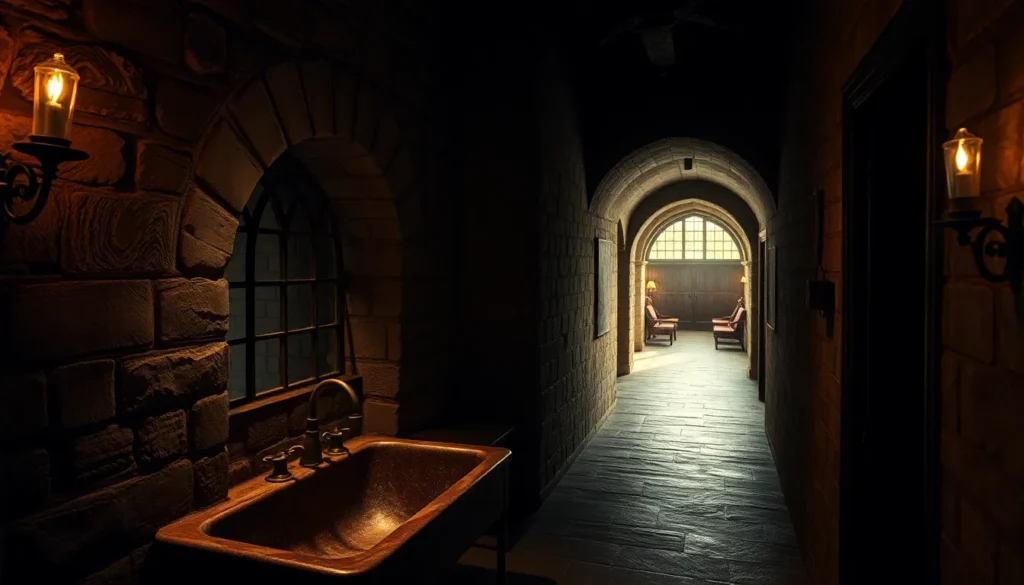Imagine stepping into a world where a simple flick of a wand can turn a pumpkin into a carriage or make your worst enemy’s hair sprout into a vibrant shade of pink. Welcome to Hogwarts, the magical school where spells aren’t just for show—they’re the key to mastering the wizarding world. From the iconic “Expelliarmus” to the mysterious “Avada Kedavra,” these incantations are more than just words; they’re a way of life for witches and wizards alike.
Table of Contents
ToggleOverview of Hogwarts Spells
Hogwarts spells encompass a wide array of magical incantations that serve various purposes. Spells can transform objects, alter appearances, and protect against threats. For example, the famous Transfiguration spell allows a witch or wizard to change a pumpkin into a carriage, a staple of magical transportation.
Key to spellcasting is the use of specific incantations. Each spell requires a unique chant to activate its effect. Expelliarmus, known for disarming opponents, stands out as a favorite among students. Meanwhile, Avada Kedavra, the killer curse, demonstrates the darker side of spellwork.
Students at Hogwarts learn spells through structured classes. Charms focuses on spells meant to enhance or modify objects. Defense Against the Dark Arts equips students with knowledge to counter dark magical threats. Mastery of spells often demands practice and guidance from experienced wizards.
The complexity of Hogwarts spells varies significantly. Some spells, like Lumos, are straightforward, producing light at the wand’s tip. Others require intricate wand movements and concentration, such as Patronus Charm, which conjures a protective guardian.
Of notable importance is the Wingardium Leviosa spell, utilized to levitate objects. Mastery of this spell indicates a student’s proficiency in charms. Additionally, Petrificus Totalus offers a means to incapacitate enemies temporarily, showcasing the balance between offensive and defensive spells.
Understanding Hogwarts spells enriches the wizarding experience. Each spell carries a legacy that extends beyond individual practice, influencing the magical community’s culture. Learning new spells remains one of the most exciting aspects of a student’s journey at Hogwarts.
Types of Hogwarts Spells

Hogwarts spells fall into several categories, each with unique characteristics and applications. Charms, hexes, jinxes, and curses represent the primary types of magic studied by aspiring witches and wizards.
Charms
Charms involve spells that add special properties to objects or individuals without changing their inherent nature. For example, the Levitation Charm, known as “Wingardium Leviosa,” allows objects to float in the air. Students practice Charms in their classes, learning essential spells that enhance everyday experiences. Other notable examples include the Summoning Charm, which brings items to the caster, and the Patronus Charm, a protective spell that conjures a spirit animal. Mastering these spells enhances practical skills and supports various magical endeavors.
Hexes
Hexes serve as minor dark spells that cause inconvenience or discomfort to the target. The most famous hex is “The Bat-Bogey Hex,” which transforms a foe’s bogeys into bats, creating chaos. Wizards and witches often use hexes in playful or competitive scenarios, highlighting their mischievous nature. While hexes lack severe consequences, they can lead to significant embarrassment for the victim. Their limited impact makes them popular among students experimenting with magic.
Jinxes
Jinxes function similarly to hexes but are typically less harmful and more subtle. For example, “The Jelly-Legs Jinx” induces a state of unsteadiness in the target’s legs, rendering them wobbly. Jinxes serve as practical tools for playful torments among friends at Hogwarts. Understanding how to cast jinxes allows students to showcase their creativity while testing their magical abilities. These spells encourage lighthearted pranks, embodying the spirit of fun in the wizarding world.
Curses
Curses represent the darkest category of magic, often causing significant harm or long-lasting effects. The “Cruciatus Curse” inflicts unbearable pain, while the “Avada Kedavra” curse results in instant death. Such spells are typically learned in advanced classes and are regarded with caution and fear. The consequences of curses deter many witches and wizards from practicing them. Safe exploration of magic and ethical considerations guide students away from this dangerous realm, emphasizing the importance of responsible spellcasting.
Notable Hogwarts Spells and Their Uses
Hogwarts spells exhibit a wide range of magical applications. Several spells stand out for their significance within the wizarding curriculum.
Expelliarmus
Expelliarmus functions as a disarming spell. It strips opponents of their weapons, showcasing the importance of non-lethal confrontation in wizarding duels. Practitioners often use this spell when they prioritize safety over aggression. Harry Potter popularized Expelliarmus through various encounters, making it a symbol of his defensive strategy. Students learn this spell in their Charms classes, where they develop an understanding of its nuances and tactical applications.
Lumos
Lumos provides a source of illumination in dark environments. It produces a beam of light from the wand tip, enhancing visibility for wizards navigating shadowy corridors or dimly lit areas. Students discover Lumos early in their magical education, as it serves practical purposes in daily life. The spell’s simplicity does not diminish its usefulness; it offers a reliable solution for illuminating spaces when no other light source exists. Mastery of Lumos allows wizards to become more self-sufficient in various situations.
Expecto Patronum
Expecto Patronum serves as a powerful protective charm against dark creatures. It conjures a Patronus, a guardian spirit that repels Dementors and similar entities. Casting this spell requires emotional strength, as the witch or wizard must access positive memories to create the Patronus. Practicing Expecto Patronum in Defense Against the Dark Arts classes empowers students to confront their fears. This spell embodies hope and resilience within the wizarding world, transforming the caster’s mindset during perilous encounters.
The Importance of Spells in the Wizarding World
Spells significantly influence the lives of witches and wizards, shaping their experiences at Hogwarts. Students learn spells to perform various magical tasks that enhance their abilities, from transforming objects to protecting against dark forces. Mastery of incantations, such as “Expelliarmus” for disarming foes and “Avada Kedavra” for lethal confrontation, illustrates the spell’s dual nature in magic.
Hogwarts provides structured courses like Charms and Defense Against the Dark Arts, where students practice spells under experienced instructors. Each class emphasizes different spell types, allowing learners to specialize in areas like hexes or charms. Examples like the Levitation Charm reflect the playful and practical applications of magic.
Practicing spells cultivates essential skills, such as wand movement and pronunciation, which are critical for successful casting. Understanding spell types—charms that alter properties, hexes that create minor inconveniences, and curses that cause harm—ensures ethical spellcasting. Students develop creativity in their approach to magic while respecting the boundaries of responsible use.
Notable spells also embody core themes of safety and resilience within the wizarding community. “Expecto Patronum” stands out as a powerful protective charm, requiring emotional strength and focus to conjure a Patronus. This highlights how spells not only serve practical purposes but also encourage personal growth and emotional development.
Overall, spells form the foundation of magical education at Hogwarts, enabling students to navigate challenges and enriching their lives in the wizarding world.
The world of Hogwarts spells is as diverse as it is captivating. Each spell carries its own unique purpose and significance within the magical community. From the playful charm of “Lumos” to the serious implications of curses like “Avada Kedavra,” spells shape the experiences of every witch and wizard.
Mastery of these incantations not only enhances magical education but also fosters personal growth and ethical considerations in spellcasting. As students navigate their journey through Hogwarts, they learn that the true power of magic lies not just in the spells themselves, but in the responsibility that comes with them. Embracing this knowledge enriches their understanding of the wizarding world and prepares them for the challenges that lie ahead.




